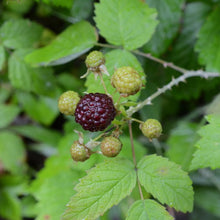
Rubus leucodermis
Blackcap raspberry is a species you grow for the delectable taste, tremendous nutritional value and habitat benefits. It's a fast-growing shrub that showcases pollinator-friendly, attractive clusters of white flowers on its branch tips in late spring. Come summer, these flowers mature into purple-black fruits that are delicious and extremely high in anthocyanins and ellagic acid. Hikers may often discover a patch after being hooked by one of its long prickly waxy white canes arching by a trail. Look closer and you might catch a glimpse of a Pacific Wren or Bushtits seeking refuge in its protective thickets.
- Plant type/canopy layer: deciduous, medium to large shrub
- Size at maturity: 2-6’ high, 3-6' wide
- Light requirements: prefers full sun, tolerates partial shade
- Moisture requirements: dry to moist soil
- Bloom time: April - July
- Growth rate/ease: fast-growing, easy to grow, spreads vigorously
- Wildlife support: flowers attract and provide nectar to hummingbirds, adult butterflies, bees and other pollinators; berries are eaten by countless species of birds and small mammals; overall plant attracts and supports beneficial and pest eating insects and is a caterpillar host and larval food source for native butterflies and moths; dense thickets provide excellent wildlife cover
- Native habitat/range: grows in moist rocky places, such as openings and edges of mixed evergreen forests, across much of western North America, from British Columbia south to California, New Mexico and Mexico. Portland Plant List - yes.
- Special features & uses: wildlife and pollinator favorite - including hummingbirds; edible and delicious; landscape uses include pollinator gardens, woodland gardens, erosion control and habitat hedgerows
Gardening with Blackcap Raspberry: This is an impressively low-maintenance plant that requires little more than being planted in a sunny area with pretty much any soil type and space to spread. Similar to other native brambles like salmonberry and thimbleberry, blackcap raspberry is thicket-forming and, over time, will create a thriving haven for birds and other wildlife, as well as an ample supply of delicious summer berries - especially if you provide it some supplemental water. Berries are ripe when they turn black. Take note if/when pruning, this species is biennial; flowers and fruit form on second year canes, then those canes die. Like with other dark raspberries, the tips of first year canes (primocanes) often droop downward toward the ground, take root when they touch the soil and become new plants. Try it intermixed with evergreen shrubs in wide habitat hedgerows, in edible areas of your native garden or in other tucked away areas on the back 40 for a tasty summer treat.
Photo Credit 1 (berries): © Alison Northup, some rights reserved (CC-BY)
Photo Credit 2 (flower): "20110605 Rubus leucodermis (Black Raspberry)" by chipmunk_1 is licensed under CC BY-SA 2.0.
Photo Credit 3 (foliage/stem): © Chris Johnson, some rights reserved (CC-BY)
Photo Credit 4 (branches in the wild): © giantcicada, some rights reserved (CC-BY)
Photo Credit 5 (late winter): © Colton Veltkamp, some rights reserved (CC-BY)









